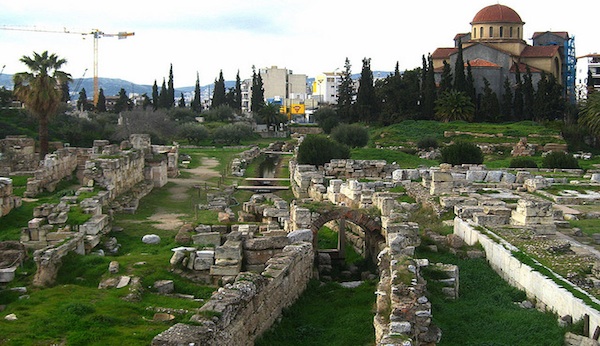The severe economic crisis that has crippled Greece for the last two years has not spared even the most previous archaeological sites in the country. One of the victims is located in Athens and is the Keramikos cemetery, a small part of the ancient area bearing the same name, one of the most important zones of Athens in ancient times, situated in the northwest part of the capital.
In ancient times, as its name suggests, it was an area inhabited by artisans who used to produce terracotta vases and other objects, whose patron was Keramos, the mythological son of Dionysus and Ariadne. The artisans established themselves in the area because of its clay-rich soils well-suited for ceramic production and abundant on the banks of the nearby Eridanos River.
This watercourse disappeared centuries ago, covered by many layers of subsequent constructions, and was revealed through excavations conducted in the 1960s. Back in 1300 BC (while some tombs date back to the early Bronze Age, 2700-2000 BC), Keramikos was used as a burial ground and maintained this function until the 4th century AD, turning into the city’s main cemetery.
The burial stones of the most important individuals of Athens at the time are found here. According to Ilias Margiolakos, an Archaeology Professor at Athens University, the precious monuments (burial stones, statues, columns and walls) of Keramikos are “bombarded” each year by rain, wind, frost and heat. The result is that the material used to build them is being destroyed. “We must take adequate measures to defend these ancient and precious monuments,” said the professor. “Hopefully – like they are saying at the Antiquities and Fine Arts Office – restoration work on several of these, like the 100m-long wall, will begin soon, before the start of the rainy season.”
For nearly a century since exactly 1913, excavations at Keramikos have been conducted by the German Archaeological Institute, which conducts research at other Greek sites, like ancient Olympus. The most recent finds date back to 2003, when several ‘kouros’ (youth) statues were uncovered, as well as two lions and a sphinx. Based on agreement signed with the Greek state, the institute is required to guarantee the preservation and restoration of the monuments. Ultimately, however, it has not been receiving the necessary funds from Berlin and therefore it is not able to honour its agreements. Until now, the outstanding collaboration between Greek and German archaeologists has not resulted in any problems. But the issue was recently discussed by the Archaeology Executive Council.
The Antiquities Department for Attica says that “it is doing what it can” for a site that is visited by over 130,000 tourists per year, and says that no systematic restoration has been carried out a Keramikos for years. German archaeologists are defending themselves, explaining that their institute gives them 25,000-30,000 euros per year for Keramikos and also pays a Greek restoration expert who looks after the site’s monuments every day. Evidently, however, these resources are not sufficient.
See all the latest news from Greece and the world at Greekreporter.com. Contact our newsroom to report an update or send your story, photos and videos. Follow GR on Google News and subscribe here to our daily email!




